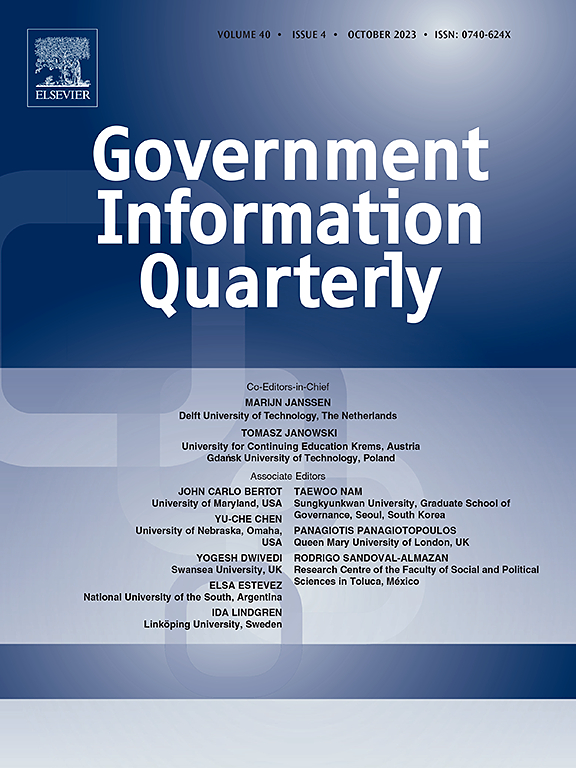揭示国家文化与人工智能计划发展和人工智能准备之间的联系:来自配置分析的见解
IF 10
1区 管理学
Q1 INFORMATION SCIENCE & LIBRARY SCIENCE
引用次数: 0
摘要
人工智能(AI)应用在公共部门的成熟度和规模都有所增加,导致人们呼吁调查人工智能对公共政策制定和结果的影响。本研究调查了Hofstede文化维度与人工智能战略计划制定和国家人工智能准备相关结果之间复杂的相互作用。利用定性比较分析(QCA),我们检查了来自33个国家的数据,以辨别这种丰富的相互作用中的模式和配置。我们的研究结果强调了串联考虑多个文化维度的重要性,揭示了一种联结关系,在这种关系中,没有单一的文化因素是独立运作的,而是应该被视为一个有凝聚力的维度组合。均等性普遍存在,表明人工智能战略计划制定和国家人工智能准备的成功和失败有无数种途径。我们还发现,与人工智能战略计划相比,国家文化与国家人工智能准备程度之间的关系更强。我们将此归因于国家人工智能准备程度是一种已知的“现状”状态的衡量标准,而人工智能战略计划是一种有抱负的“未来”状态的表达,人工智能作为技术的颠覆性新颖性和人工智能领域的不成熟加剧了这种差异。我们预计,随着该领域的成熟和随后的政策迭代的发展,国家文化与战略人工智能计划的关系将随着各国将这些计划与本国情况相结合而加强。均等性表明,每个国家都可以找到自己的道路,虽然民族文化在今天提供了有价值的见解,但未来的研究应该探索,随着时间的推移,不断变化的文化、制度和政策背景如何影响人工智能战略计划的适应和完善。本文章由计算机程序翻译,如有差异,请以英文原文为准。
Unraveling the Nexus between National Culture and AI plan development and AI readiness: Insights from a configurational analysis
Artificial intelligence (AI) applications have increased in maturity and scale across the public sector, leading for calls to investigate AI's impact on public policy development and outcomes. This study investigates the intricate interplay between Hofstede's cultural dimensions and outcomes related to strategic AI plan development and national AI readiness. Utilizing qualitative comparative analysis (QCA), we examine data from 33 nations to discern patterns and configurations within this rich interplay. Our findings underscore the significance of considering multiple cultural dimensions in tandem, revealing a conjunctional relationship where no single cultural factor operates independently but rather should be viewed as a cohesive portfolio of dimensions. Equifinality is prevalent, indicating myriad pathways to both success and failure in strategic AI plan development and national AI readiness. We also find the relationship between national culture and national AI readiness stronger than that with strategic AI plans. We attribute this to national AI readiness being a measure of a known “as-is” state compared to strategic AI plans being an expression of an aspirational “to-be” state, a difference accentuated by the disruptive novelty of AI as technology and hence the immaturity of the AI field. We expect that, as the field matures and subsequent iterations of policy are developed, the national culture's relationship with strategic AI plans will strengthen as countries align those plans with their circumstances. Equifinality suggests that each country can find its own path, and while national culture offers valuable insights today, future research should explore how evolving cultural, institutional, and policy contexts shape the adaptation and refinement of strategic AI plans over time.
求助全文
通过发布文献求助,成功后即可免费获取论文全文。
去求助
来源期刊

Government Information Quarterly
INFORMATION SCIENCE & LIBRARY SCIENCE-
CiteScore
15.70
自引率
16.70%
发文量
106
期刊介绍:
Government Information Quarterly (GIQ) delves into the convergence of policy, information technology, government, and the public. It explores the impact of policies on government information flows, the role of technology in innovative government services, and the dynamic between citizens and governing bodies in the digital age. GIQ serves as a premier journal, disseminating high-quality research and insights that bridge the realms of policy, information technology, government, and public engagement.
 求助内容:
求助内容: 应助结果提醒方式:
应助结果提醒方式:


